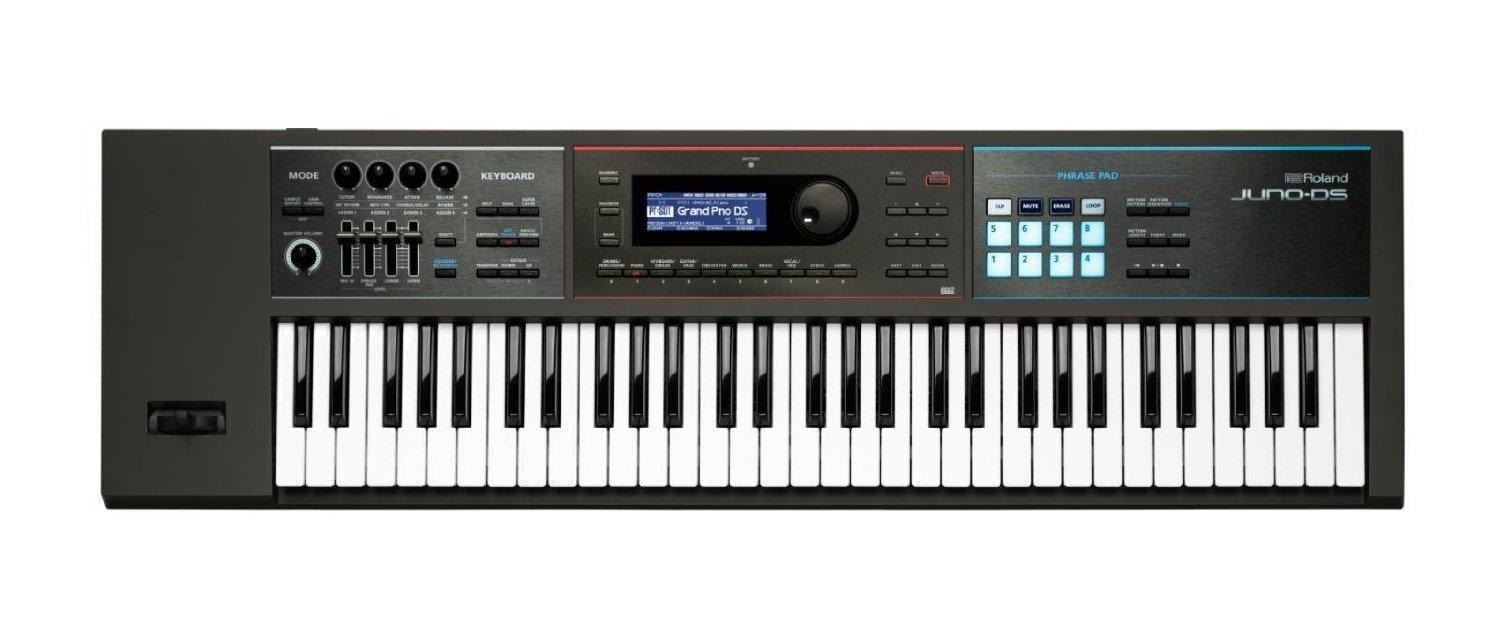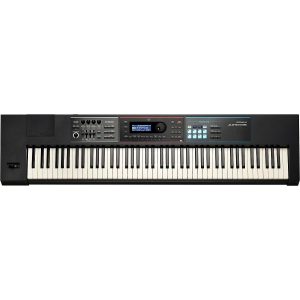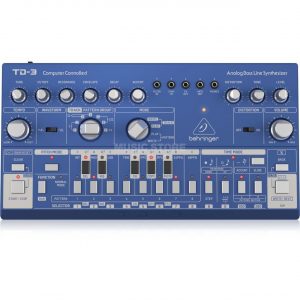Roland Juno-DS61
$495.99
Get ready to take your music to a new level with the Roland Juno-DS61 synthesizer, packed with amazing features and a sleek design!
Compare
Description
The Roland Juno-DS61 is a 61-key synthesizer designed for performing musicians and producers. It features a wide range of sounds and advanced features, including waveform synthesis, multi-timbral capability, and a versatile arpeggiator.
One of the standout features of the Juno-DS61 is its sound engine, which is based on Roland’s proprietary Analog Circuit Behavior technology. This allows the instrument to accurately recreate the sound of classic analog synthesizers, as well as provide access to an extensive library of modern and vintage sounds. The Juno-DS61 also includes over 1,000 patches, including basses, pads, leads, and drums, as well as an array of built-in effects, including reverb, chorus, and delay.
Another noteworthy feature of the Juno-DS61 is its multi-timbral capability. This means that the instrument can play multiple sounds simultaneously, making it ideal for layering and splitting sounds on stage. Additionally, the Juno-DS61 features a versatile arpeggiator, which allows for quick creation of complex and dynamic patterns.
In terms of connectivity, the Juno-DS61 includes a variety of inputs and outputs, including USB audio/MIDI, 5-pin DIN MIDI, and stereo audio outputs. There is also a stereo input for processing external audio sources through the synth’s effects. The Juno-DS61 can also be used as a USB audio/MIDI interface, allowing for easy integration into a digital audio workstation.
Overall, the Roland Juno-DS61 is a versatile and powerful synthesizer that offers a wide range of sounds and advanced features. Whether you’re a performing musician, producer, or just looking for a high-quality synthesizer to add to your studio, the Juno-DS61 is a great choice.
Roland Juno-DS61 properties
| Product name |
Juno-DS61 |
| Brand |
Roland |
| Type |
Keyboard Instruments |
| Keyboard Instrument |
Synthesizer |
| Drawbars/Sliders |
Yes |
| Pads |
Yes |
| Rotary Controls |
Yes |
Frequently Asked Questions:
What is the maximum number of patches and performances that can be stored in the internal memory of a Roland Juno-DS61 synthesizer?
The Roland Juno-DS61 synthesizer has 1200 patches and 320 performances (song sequences) that can be stored in its internal memory. This allows for a wide range of sounds and compositions to be saved and recalled easily during live performances or studio sessions.
What are the unique features and capabilities of the Roland Juno-DS61 synthesizer, and how can I best utilize them to enhance my music production?
The Roland Juno-DS61 synthesizer is a versatile and powerful instrument that offers a range of unique features and capabilities for music production. Here are some of its standout aspects and ways you can maximize their potential:
1. Sound Library: The Roland Juno-DS61 comes with a vast library of over 1,200 high-quality sounds covering a wide range of genres and styles. From classic analog to modern digital, this synthesizer has everything you need to create your desired sound. You can access these sounds easily using the intuitive panel layout and the dedicated sound selection buttons. To best utilize this feature, take some time to explore the various sounds available and find the ones that work best for your specific musical needs. You might also consider creating custom patches by tweaking the parameters of existing sounds or combining multiple sounds together. Phrase Pad: The Juno-DS61's Phrase Pad allows you to load and play back up to four stereo audio phrases simultaneously. These phrases could be anything from vocal samples, drum loops, or atmospheric soundscapes that can add depth and texture to your music. You can control the pitch, volume, and pan of each phrase separately using the dedicated knobs. To make the most of this feature, consider using the Phrase Pad to add some dynamic elements to your live performances or as a creative tool during the production process. For instance, you could use it to trigger pre-recorded guitar riffs, basslines, or percussion loops that would be challenging to reproduce in real-time. Arpeggiator: The Juno-DS61's arpeggiator is a powerful tool that can help you create complex and intricate rhythmic patterns automatically. This feature generates notes based on the chords you play, which can be great for adding movement and energy to your music. You can customize various aspects of the arpeggio such as the rate, swing, and gate time using the dedicated controls. To make the most of this feature, try experimenting with different arpeggiator settings and patterns to find what works best for your musical ideas. This tool could be especially useful in genres like electronic dance music, where complex rhythms are a significant part of the sound. Connectivity: The Roland Juno-DS61 offers multiple connectivity options that allow you to integrate it into various production setups. It has MIDI inputs and outputs as well as USB and AUX connections. You can use these features to send and receive MIDI data, connect to other devices like sequencers or DAWs, and even play live using the built-in speaker system. To best utilize this feature, consider connecting your Juno-DS61 to a computer running a Digital Audio Workstation (DAW) to take advantage of its advanced production tools. You can use it as a MIDI controller or as a standalone synthesizer by routing audio signals through the AUX output and back into your DAW. In conclusion, the Roland Juno-DS61 synthesizer offers a range of unique features and capabilities that can significantly enhance your music production process. By understanding how to utilize these features effectively, you'll be able to create more dynamic and engaging music that stands out from the crowd. Whether you're a beginner or an experienced musician, this synthesizer is a must-have tool for anyone looking to elevate their musical craft.
How does the SuperNATURAL sound engine in the Roland Juno-DS61 synthesizer enhance the quality and realism of its sounds compared to previous models?
The SuperNATURAL sound engine in the Roland Juno-DS61 synthesizer significantly enhances the quality and realism of its sounds compared to previous models. This advanced technology uses cutting-edge behavior modeling techniques to recreate the characteristically unpredictable and emotional capabilities of naturally occurring objects, animals and physical events. It also provides unique sound-shaping features like Inflection and Tone Wheel that offer unprecedented detail and expressiveness. Overall, the SuperNATURAL engine delivers richer, more vibrant sounds with a greater sense of space and movement.
"How can I effectively program and manipulate the SuperNATURAL sounds on the Roland Juno-DS61 synthesizer to achieve a wide range of realistic and expressive musical textures?"
To effectively program and manipulate the SuperNATURAL sounds on the Roland Juno-DS61 synthesizer to achieve a wide range of realistic and expressive musical textures, you can follow these steps:
1. Familiarize yourself with the SuperNATURAL engine: The SuperNATURAL technology in the Roland Juno-DS61 synthesizer is designed to create highly realistic and expressive sounds. Take some time to explore the different categories of sounds available, such as pianos, strings, brass, and synths. Listen to how these sounds respond to your touch and expression, as well as how they interact with other instruments in a band or ensemble setting. Use the SuperNATURAL Acoustic Creation (SAC) feature: The SAC technology in the Roland Juno-DS61 allows you to manipulate and enhance the acoustic properties of your sounds, such as resonance, attack, and release time. This can help you achieve a more natural and realistic sound, especially for instruments like pianos, guitars, and percussion. Utilize the onboard effects: The Roland Juno-DS61 comes with a variety of built-in effects that you can use to shape your sounds and create unique textures. These include reverb, chorus, delay, phaser, and more. Experiment with different combinations of effects to find the right sound for your needs. Use the modulation matrix: The modulation matrix in the Roland Juno-DS61 allows you to assign various parameters of your sounds to different controllers, such as your keyboard, knobs, or pedals. This can help you create more expressive and dynamic performances by allowing you to vary the sound in real time. Utilize the arpeggiator: The arpeggiator in the Roland Juno-DS61 allows you to generate complex musical patterns automatically, which can be useful for creating background textures or adding interest to your solos. You can also sync the arpeggiator to an external MIDI clock, which can help you stay in time with other musicians. By following these steps and exploring the full range of features available on the Roland Juno-DS61 synthesizer, you should be able to achieve a wide range of realistic and expressive musical textures.





Alex Peay –
A great sounding professional instrument with a toy appearance. By setting the voice dial to a position between any of the modes and turning on the voltage, you will get piano simulations (such a mistake of engineers and a gift for the user).
The effects work great, giving a lot of possibilities to create the sound. With a clear conscience, I will recommend it even to people who have never been associated with keyboards, to expand their skills, possibilities and explore the theory of music (nothing develops a guitarist like a keyboard). In the era of ubiquitous shit and trash, I recommend it